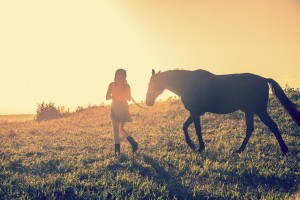Laminitis: The Disease Horse Owners Need to Know About
 You may remember a horse named Barbaro from a few years back. In 2006 this previously undefeated Thoroughbred racehorse impressively swept the Kentucky Derby. With much chatter about a Triple Crown contender, the nation’s heart broke as we watched him shatter his leg two weeks later in the Preakness.
You may remember a horse named Barbaro from a few years back. In 2006 this previously undefeated Thoroughbred racehorse impressively swept the Kentucky Derby. With much chatter about a Triple Crown contender, the nation’s heart broke as we watched him shatter his leg two weeks later in the Preakness.
If you remember, though, it wasn’t that awful fracture that ended Barbaro’s life. He had the care of the best equine surgeons in the country and lived for another eight months before something else took his life: laminitis. This equine ailment is a serious threat to race horses and pasture ornaments alike. All horse owners should be familiar with what laminitis is, how to recognize it, and what they can do to prevent their horse from being affected.
What is Laminitis?
Laminitis is a painful, common, and costly disease that affects many horses and ponies every year. It simply refers to inflammation of the laminae of the hoof. These delicate structures connect the hoof wall to the coffin bone and stabilize the bones in the foot.
When the laminae become inflamed, the bone inside the hoof may begin to rotate away from the wall. This can lead to serious damage to the hoof, resulting in lameness or even the exposure of the bone through the bottom of the foot.
Horses experiencing laminitis may:
- Have a shortened stride
- Be reluctant to move
- Place feet quickly on the ground, avoiding bearing weight
- Stand with a “rocked back” appearance
- Lie down and be hesitant to rise
- Have bounding digital pulses
- Have warmth in the feet
If you think that your horse may be experiencing laminitis, do not wait to seek help. The earlier a horse is treated, the more likely we will be able to help.
How Can Laminitis be Prevented?
There is still much to be learned about laminitis. We don’t always know what causes it when a horse founders, but we do know that there are some common causes. These include:
- Stress
- Digestive upset
- Carbohydrate overload
- Systemic illness including colic
- Metabolic disease
- Excessive weight bearing on a single limb
- Concussion to the feet (Road founder)
- Exposure to black walnut shavings
- High doses of steroids
- Excessive ingestion of cold water
When possible, these things should be avoided. Perhaps the most avoidable cause of sudden laminitis is introduction to pasture too quickly in the spring.
Young, spring grass contains a large amount of carbohydrates. When horses are turned out on this rich grass, their laminitis risk increases if they are allowed to consume it freely.
In order to avoid pasture-induced laminitis, it is important to allow the pasture to grow six to eight inches before allowing horses to graze. This allows the grass to mature and become less carbohydrate laden. When first beginning turnout in the spring, only allow about 15 minutes of grazing. You may increase grazing time by 15 minutes a day until four or five hours of grazing is reached. Thereafter horses may graze freely.
Some horses and ponies that are prone to metabolic disease may need to be further restricted from grazing. Using a grazing muzzle can help to control the intake of these individuals.
Laminitis is a very common problem of the horse and one that every horse owner should be familiar with. Knowing the potential triggers for laminitis episodes and how to recognize them is an important way to protect your equine companions. If you have any questions about how to help your horse or prevent laminitis, please let us know. We are always here to help.
“Dr. Yetter’s professional & compassionate care enabled us to have Lady as a member of our family for over 17 years. Through his knowledge, extensive research, and willingness to reach out, he provided Lady with a long quality life in spite of numerous health issues. We are eternally grateful.”
— Diane & Terry Svob
“Dr. Yetter and the staff at Prairie Ridge have given excellent care to my family of pets for about 20 years. I always feel comfortable asking questions and knowing I will get complete, caring answers. Dr. Yetter researches to find the best treatment options. My cats and dog are family to me, and we trust Prairie Ridge Veterinary Clinic.”
—Janis Blout
“We are so grateful for the hard work and extra research Dr. Yetter did for our Tansy-cat to find out why she wasn’t eating. If there is a time when your most precious friend is ill and you need to trust someone to care for them, Dr. Yetter is definitely that person! He went above and beyond to do everything he could to save our beautiful Tansy.”
— Tom & Bev Berberett
“My pets have been patients of Dr. Yetter and his great staff for many years, and I have always been grateful for their efficiency and helpfulness. Having good care right here in Havana is a big plus!”
— Jan McFarlin
“I began to bring in my labs into PRVC when I started working there, and was happy to have such a caring and knowledgeable doctor to take care of two of my best friends. It always amazes me just how much care goes into each and every animal, let alone the perseverance of Dr. Yetter and staff (I should call them family) in working out how to treat each and every problem.”
— Chris Johnson

